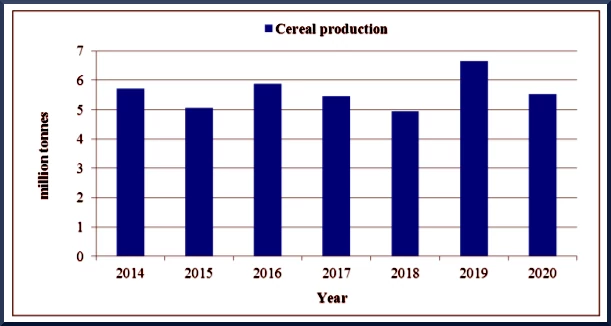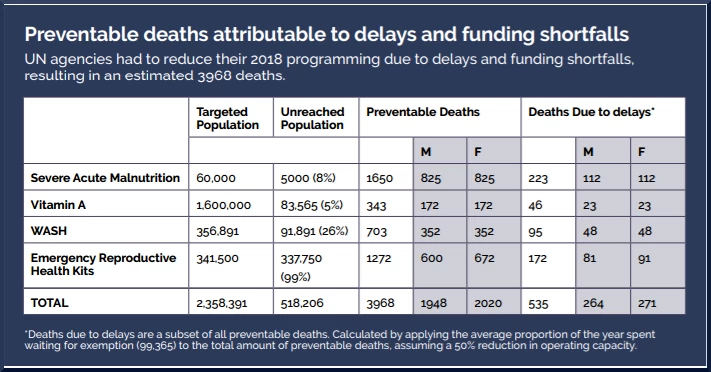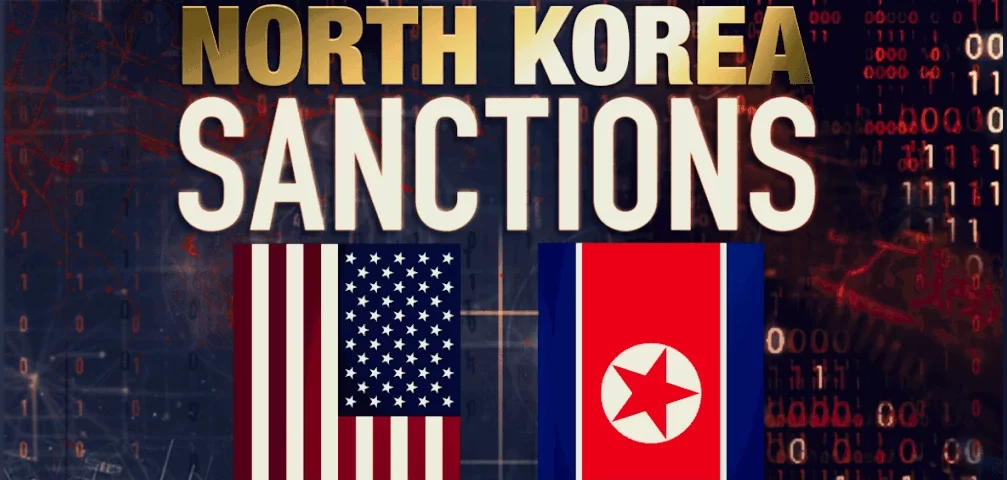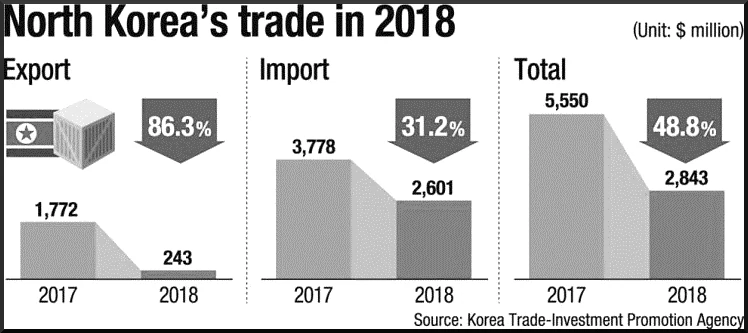by Erica Jung, September 30, 2022
Introduction
North Koreans live under restrictions, embargoes, and scarcities imposed and enforced by a variety of sanctions from the United States and the United Nations.1 In fact, north Korea is one of the most sanctioned countries in the world, having been subject to sanctions since its foundation in 1950. US sanctions in particular serve as imperial tools of control, seeking to undermine the existence of a socialist state that poses a direct threat to its hegemonic power. By casting north Korea as an evil and hostile threat to world peace, the US is able to justify its intervention in peninsular politics and its use of sanctions as economic warfare.
Current Events and Historical Background
The Biden administration announced on June 20, 2021 that it was extending Executive Order 13466,2 a largely symbolic move that extends the national emergency over north Korea’s nuclear capabilities, by another year.3 President Biden argued that north Korea’s “pursuit of nuclear and missile programs…continues to constitute an unusual and extraordinary threat to the national security, foreign policy, and economy of the United States.”4 Furthering US hostility towards north Korea, the Biden administration later announced a series of new sanctions targeting individuals and entities in China, Russia, north Korea, Bangladesh, and Myanmar on December 10, 2021, the 73rd anniversary of Human Rights Day.
The president’s first new sanctions on north Korea were imposed on Russian university European Institute Justo and its provost, Dmitriy Yurevich Soin, for allowing north Korean students to work in Russia through a student visa program. The US Treasury Department had voiced concerns that the foreign currency earnings would go towards north Korea’s “unlawful weapons of mass destruction and ballistic missile programs.”5 The Treasury Department also blacklisted north Korea’s Central Public Prosecutors Office, along with the former minister of social security and Minister of People’s Armed Forces, Ri Yong Gil.
In a clear show of hypocrisy, the US agreed “in principle” to an End-of-War Declaration three days after it announced this new round of sanctions. This declaration would bring a formal end to the Korean War, which concluded in 1953 with an armistice but not a peace treaty.6 While the effort was mostly led by the Republic of Korea (ROK) and the US, both parties have failed to address any of the conditions that north Korea had asked for, such as lifting certain sanctions and stopping military exercises. Meanwhile, the US continues to employ sanctions pressure and isolation tactics against north Korea, undermining the country’s sovereignty.
In order to understand sanctions on north Korea today, it is important to understand why they were imposed in the first place and the motivations behind their continued use. Shortly after the outbreak of the Korean War in 1950, the US imposed an export ban on north Korea and forbade financial
transactions by, or on behalf of, north Korea, including transactions for travel.7 In 2003, when north Korea began its nuclear tests, the US started to ease trade and travel sanctions under the Bush and Obama administrations to facilitate negotiations around north Korea’s denuclearization. However, sanctions were reinstated “when the negotiations failed to produce the results desired by the US.”8 Today, the threat of sanctions continues to serve as a major barrier to renewing peace talks between the two Koreas.
The events outlined above can be understood by examining the US State Department’s on-again-off-again approach to including north Korea on the State Sponsors of Terrorism list. In 1988, north Korea was added to the US State Department’s State Sponsors of Terrorism list. 20 years later, north Korea was removed from the list in 2008 only to be re-added back in 2017 under the Trump administration.9 More recently, the Biden administration renewed north Korea’s designation to the list.10 Described by former State Department official Joseph DeThomas as “more of an art than a science”, designation to the list is a key strategy for the US to continue to justify and fully institutionalize brutal sanctions. Meanwhile, north Korea’s temporary removal from the list is part of the same calculated effort towards cornering the country into negotiations around denuclearization in exchange for the US easing their imposed sanctions.
Financial Impact of Sanctions on north Korea
The US targets north Korea with unilateral sanctions that “restrict more economic activities and target a larger list of individuals and businesses than the UN sanctions.”11 Since 2008, the US has issued several executive orders that have expanded the impact and scope of its sanctions on north Korea.12, 13 In 2016, President Obama issued Executive Order 13722, freezing any property belonging to the government of north Korea or the Workers’ Party of Korea that appears to be under the jurisdiction of the US and prohibiting the export or re-export of any goods, services, or technology from the US, or by a US person, to north Korea.14 Freezing the property of members of the Workers’ Party of Korea essentially amounts to stealing from everyday Koreans as the party’s membership stands at 6.5 million people, or a quarter of north Korea’s population.15
President Trump’s Executive Order 13810, issued in 2009, expanded the scope of US sanctions against north Korea. The order authorizes the Department of Treasury to enforce sanctions against any individual or entity that trades with north Korea, 16 employing a strategy of secondary sanctions that mainly target foreign individuals and entities for participating in activities that may not be under US jurisdiction.17 This tactic is used to pressure companies worldwide into severing their ties with any businesses involving north Korea. As President Trump stated in 2017, “foreign banks will face a clear choice: Do business with the United States or facilitate trade with the lawless regime in north Korea –and they won’t have so much to trade.”18 Parties that are subject to secondary sanctions can lose access to the US market.19 As a result, north Korea becomes further impacted by overcompliance, or “the tendency of firms to avoid sanctioned countries for fear of repercussion, even when it may be within their rights to interact with the country.”20 Through its use of sanctions, the US has effectively blocked north Korea from engaging in the US financial system and any dollar-based transactions.21
While unilateral US sanctions on north Korea date back to 1950, the UN Security Council (UNSC) has levied increasingly severe multilateral sanctions since 2006 over concerns about north Korea’s nuclear weapon program.22 The first generation of UN sanctions were “smart sanctions”, and targeted state and party leaders by restricting the supply of weapons, missile technology and material, and select luxury goods.23 These sanctions were implemented in response to north Korea’s first nuclear test.24
The second generation of UN sanctions, created in response to the fourth north Korean nuclear test in 2016, were “sectoral sanctions.”25 Sectoral sanctions were applied indiscriminately towards entire sectors of north Korea’s economy, irrespective of these sectors’ ties to the nuclear program. These sanctions have had particularly devastating effects on the north Korean economy, as the UN resolutions target top export industries, preventing north Korea from bringing in external revenue that could be used for the country and its people. The list of industries directly targeted include: the mineral trade, seafood, textiles, and agricultural products, machinery and electrical equipment. In terms of imports, the resolutions significantly limit north Korea’s import of energy, ban the import of heavy machinery, industrial equipment and transportation vehicles, and forbid any joint ventures with north Korean entities, thereby blocking any foreign investment.
Through each new resolution, the UN Security Council has progressively isolated north Korea from access to international capital. Collectively, both UN sanctions and unilateral US sanctions have resulted in an “almost total ban on DPRK-related trade, investment, and financial transactions.”26 North Korea’s trade was halved in 2018 as a result of UN sanctions.27 As the graph below shows, north Korea’s exports plunged by 86.3 percent while imports declined by 31.2 percent. A decline in exports at such a high rate signals a downturn in the economy as national markets struggle to export goods, leading to shortages of foreign currency.28
The financial impacts of sanctions, however, go beyond the country’s economic development. By broadly impacting north Korea’s national economy, sanctions inevitably take a humanitarian toll on the entire population by undermining their ability to survive. Humanitarian organizations – including UN agencies – face many barriers in their distribution of aid as sanctions have dissuaded banks from managing any transactions involving north Korea. North Korean state agencies are also affected by sanctions, which likewise prevent their access to many essential supplies. Some of the biggest humanitarian challenges facing the country include “chronic food insecurity; lack of access to basic health services; declining conditions in water, sanitation, and hygiene (WaSH); and high vulnerability to natural disasters.”29 From hand-tools to aluminum wire, the long list of banned items affects many aspects of everyday life and presents serious challenges to social and economic development.
Humanitarian Challenges and National Resilience
From 1989 to 1991, north Korea lost 80 per cent of its foreign trade as the Soviet Union collapsed. Oil imports from Russia were stopped completely and imports from China declined significantly. Two devastating floods swept the country in 1995 and 1997, destroying entire industries as mines flooded and roads were washed away. The period of famine and suffering that resulted from these factors, otherwise known as the Arduous March, lasted about 16 years, from 1994 to the end of 2009. All of north Korea’s key industries either stopped or decreased production.
North Korea persevered through this time of hardship and has shown remarkable strength and determination in overcoming these many challenges. Since the Arduous March, the country has been gradually recovering, having developed its own technology and infrastructure to rebuild, feed, and clothe its people. Socialist development in north Korea has centered itself on juche ideology, which “entails a combination of self-reliance, self-sufficiency, and self-confidence.”30 As such, the north Korean people continue to stay resilient and adapt to the many challenges they face through remarkable advancements in agriculture, energy, and textile and steel production.
Still, sanctions are a major impediment to recovery. UN sanctions negatively impact north Korea’s overall food production by banning seeds, fertilizers, and agricultural equipment and other types of machinery.31 According to the 2020 Needs and Priorities report compiled by the UN Resident Coordinator for north Korea, “around 10.1 million people, or 39.6 percent of the country’s population, are food insecure.”32 Contrary to popular narratives that claim north Korea’s government is intentionally withholding food from its population, the UN Resident Coordinator is quite clear that “food insecurity in the country is driven by a lack of access to modern agricultural equipment and techniques;33 and is amplified by recurrent natural disasters and the impacts of climate change.”34 In fact, north Korea has a public food distribution system, but is unable to access the necessary agricultural imports from the world market. Moreover, the impact of sanctions on north Korean agriculture must be considered in combination with the effects of division, as northern Korea is prevented from relying on Korea’s historic breadbasket in the south for foodstuffs.
In response to the restrictions placed on imports of petroleum and by-products of petroleum like Caprolactam, north Korea has crafted alternative means to produce fertilizer and fabric. Through livestock cooperative farms, all businesses, factories, schools, mining companies, and military units feed livestock for their own use. The animal excrement ends up being used as a raw material for organic fertilizer, allowing for a more sustainable circular production system.35 Tidal flats have also been developed to obtain new farmland, with the government reclaiming up to 13,000 hectares of land in 2021.36 By waging an “intensive drive for scientific farming and high yield,” north Korea was able to produce 6.65 million tons of cereal in 2019, “the highest yield during the last 10 years.”37 However, due to consecutive typhoons and floods, cereal production was reduced to 5.52 million tons in 2020.

North Korea has also made significant investments in the C1 (Carbon 1) chemical industry in order to overcome its difficulties with obtaining oil, shifting away from petrochemistry.38 Through this industry, “a variety of chemical products and oil can be produced from coal,” including gasoline, synthetic fiber, synthetic resins, synthetic rubber, agricultural pesticides, paints, medicines, and chemical fertilizer.
One of the products that came out of C1 chemistry is vinalon, a synthetic fiber made with coal and limestone that was first developed in 1939. While the extraction of chemical fibers from petroleum was becoming a globalized trend, the shortage of raw materials from sanctions led to the shut down of a chemical fiber production plant in north Korea.39 In shifting towards a more self-reliant economy, north Korea started industrial production of vinalon in 1961 with the establishment of the 2.8 Vinalon Joint Enterprise.40 Otherwise known as ‘Juche fibre’, vinalon became the national fiber of North Korea and is used to produce clothing, shoes, ropes, and quilt wadding.41
While pursuing self-reliant solutions to food insecurity and commodity production-related challenges caused by sanctions, north Korea has also had to navigate the effects of sanctions on its water, sanitation, hygiene and healthcare infrastructure. According to UNICEF, over 9.75 million people do not have access to safely managed drinking water;42 83.2 per cent of households do not use any water treatment method; and 36.6 per cent have contaminants43 in their drinking water.44 Moreover, “half of all schools and health facilities lack adequate water and sanitation facilities.”45
The low quality of WaSH services adds to especially high rates of diarrhea and pneumonia; in 2015, “37 per cent of deaths among children aged between 7 days and 5 years in the 12 provinces of central hospitals were caused by pneumonia, while 34 per cent died of diarrhea.”46,47 north Korea is also one of the 30 highest tuberculosis (TB) burdened countries, with an estimated 513 cases per 100,000 people, most of which are attributable to undernourishment.48
These developments are especially concerning given the list of banned items that could be used to prevent and treat these health problems. Although north Korea has a more developed healthcare system relative to countries with similarly sized economies, health facilities throughout the country often face shortages in essential medical equipment and medicines, preventing them from providing quality health services. Under UN sanctions, all metal items are banned, including sterilizers for medical use; ambulances; medical appliances;49 x-ray machines; medical, surgical, dental, or veterinary furniture (ie operating tables, hospital beds); machinery for filtering or purifying water; and metal tubes, pipes, pipe fittings, etc.50 The shortages of medical equipment undermine north Korea’s ability to provide comprehensive healthcare for all its citizens, something guaranteed to be free in its constitution.51
While there exists a UN mechanism for case-by-case humanitarian exemptions, it is “insufficient to prevent these negative impacts, given that it is of an ad hoc and corrective nature rather than a systematic and preventive one.”52 Applicants for exemptions, mainly international and non-governmental organizations, face significant challenges, from long wait times for review and approval of exemptions requests to unrealistic shipping requirements.53 These administrative barriers to humanitarian aid have had fatal consequences. As the table below shows, delays and funding shortfalls resulted in an estimated 3,968 preventable deaths in just 2018.

While advocates push for lower barriers to humanitarian aid, the deaths caused by medical shortages are a function of the presence of sanctions, rather than an absence of adequate exemptions. Despite having national public education, childcare, and healthcare programs, sanctions affect north Korea’s ability to provide adequate maternal and neonatal care, sanitation infrastructure, and ultimately stop preventable deaths. Aid can help address problems in the short-term, but in the long-term, sanctions and other tools of control must be lifted to allow north Koreans the ability to live their own way by their own efforts.
While advocates push for lower barriers to humanitarian aid, the deaths caused by medical shortages are a function of the presence of sanctions, rather than an absence of adequate exemptions. Despite having national public education, childcare, and healthcare programs, sanctions affect north Korea’s ability to provide adequate maternal and neonatal care, sanitation infrastructure, and ultimately stop preventable deaths. Aid can help address problems in the short-term, but in the long-term, sanctions and other tools of control must be lifted to allow north Koreans the ability to live their own way by their own efforts.
Gendered Impact of Sanctions
Sanctions on north Korea have also led to particularly negative consequences for women’s health, including reproductive and maternal health. While north Korea’s maternal mortality rate, which stands at 89 deaths per 100,000 live births as of 2017, has “never reached the highs prevailing in low income and least developed countries and remained below world averages”54, shortages of life-saving drugs, such as oxytocin55 and magnesium sulfate,56 along with poor nutrition continue to harm women’s health.
Sanctions against north Korea harm women in many ways. While the state has made significant legislative achievements in order to protect and elevate women’s status in society,57 gender roles in north Korea continue to make life hard for north Korean women, who “are particularly exposed to the impact of sanctions because of the twin expectation that they be primary caretakers of their families and communities as well as workers fully integrated in the socialist economy.”58
Women make up almost half of the workforce (47.8 per cent), and yet they dominate the sectors most impacted by sanctions, such as health and welfare services, fisheries, and textiles.59 The ban on exports of seafood and textiles negatively affects the ability of women to sustain themselves and their families. Additionally, many women are involved in market trade, which was legalized in response to the harsh economic effects of sanctions and is considered to be a primarily female occupation in north Korea. While “growing market participation could present an opening for improving women’s economic and social status in north Korea,” sanctions “exacerbate women’s job insecurity and undermine their standing in society” by weakening trade.60
Conclusion
In total, sanctions imposed on north Korea by the US, UN, and other countries48 target over 150 companies and 200 individuals today, the effects of which trickle down to north Korea’s larger population.49 By hindering north Korea’s economic development and the delivery of humanitarian aid, sanctions have reversed the gradual improvements that north Korea had made in recovering from the Arduous March.
While sanctions have severely restricted north Korea’s ability to trade with other countries and receive humanitarian aid, north Korea has stood up to US threats and continues to maintain its independence and survive. Despite the many restrictions that have been placed on a variety of imports, one of the most important ones being oil, north Koreans have found ways to circumvent these obstacles and produce goods for their own people through the most creative and innovative means. They are adapting their lives because of sanctions, in acts of resistance and survival, as the national ideology of juche manifests itself in all parts of the north Korean economy.
Nonetheless, as long as north Korea exists, the US will continue to police the country through sanctions and other tools of foreign aggression. The US claims it imposes these sanctions in the name of human rights, “yet the tremendous death toll of sanctions themselves reveal these claims to be little more than an alibi for the US’ true aims: unfettered access to global markets and resources, underpinned by planetary militarization and occupation.”
The socialist state of north Korea and everything it has achieved are a direct threat to the US-dominated imperialist system that sanctions play a role in upholding. The international community must accept the north Korean sovereignty and provide support rather than isolate, vilify, or strong-arm them. In order to move forward with reunification, we must promote peace and cooperation between the Koreas and reject US imperialism in all forms.
This article is featured from “Sanctions: A Wrecking Ball in a Global Economy”. Various Authors discuss the effect of sanctions on local, regional and global economies. You can pre-order the book on the International Action Center website: HERE.
Footnotes:
- https://nodutdol.org/wp-content/uploads/2020/10/Sanctions-of-Empire.pdf
- Executive Order 13466 was first issued on June 26, 2008, in response to north_Korea’s nuclear weapons program.
- https://www.whitehouse.gov/briefing-room/presidential-actions/2021/06/21/notice-on-the-continuation-of-the-national-emergency-with-respect-to-north-korea/
- https://www.whitehouse.gov/briefing-room/statements-releases/2021/06/21/letter-to-the-speaker-of-the-house-of-representatives-and-the-president-of-the-senate-on-the-continuation-of-the-national-emergency-with-respect-to-north-korea/
- https://thehill.com/policy/international/585308-biden-sanctions-dozens-accused-of-human-rights-abuses-including-china
- https://www.theguardian.com/world/2021/dec/13/north-south-korea-agree-in-principle-formal-end-war-us
- https://nodutdol.org/wp-content/uploads/2020/10/Sanctions-of-Empire.pdf
- https://nodutdol.org/wp-content/uploads/2020/10/Sanctions-of-Empire.pdf
- https://www.washingtonpost.com/news/worldviews/wp/2017/11/20/north-koreas-on-again-off-again-status-as-a-state-sponsor-of-terrorism/
- https://en.yna.co.kr/view/AEN20211217000251325
- https://www.cfr.org/backgrounder/what-know-about-sanctions-north-korea
- https://home.treasury.gov/policy-issues/financial-sanctions/sanctions-programs-and-country-information/north-korea-sanctions
- The six executive orders include: 13466 (2008), 13551 (2010), 13570 (2011), 13687 (2015), 13722 (2016), and 13810 (2017).
- https://home.treasury.gov/system/files/126/nk_eo_20160316.pdf
- https://www.news1.kr/articles/?4172242
- https://home.treasury.gov/system/files/126/13810.pdf
- https://www.skadden.com/insights/publications/2017/09/us-dramatically-increases-sanctions-on-north-korea
- https://kr.usembassy.gov/092117-remarks-president-trump-president-moon-rok-prime-minister-abe-japan/
- https://www.skadden.com/insights/publications/2017/09/us-dramatically-increases-sanctions-on-north-korea
- https://nodutdol.org/wp-content/uploads/2020/10/Sanctions-of-Empire.pdf
- <https://fpif.org/the-problem-of-sanctions-against-north-korea/>
- https://koreapeacenow.org/wp-content/uploads/2019/10/human-costs-and-gendered-impact-of-sanctions-on-north-korea.pdf
- https://www.cfr.org/backgrounder/what-know-about-sanctions-north-korea
- The first generation of sanctions included the following resolutions: 1718 (2006), 1874 (2009), 2087 (2013), 2094 (2013), and 2270 (2016).
- The second generation of sanctions included the following resolutions: 2321 (2016), 2371 (2017), 2375 (2017), and 2397 (2017).
- Ibid (p.1)
- https://www.koreatimes.co.kr/www/nation/2019/07/103_272576.html
- KPN, p.11
- KPN report
- https://foodfirst.org/wp-content/uploads/2013/12/PB11-Famine-in-North-Korea-Christine-Ahn.pdf
- Items prohibited under sectoral sanctions in UN Resolution 2397 that affect food production include: hand-tools for agriculture, blades for agricultural, horticultural or forestry machines, dryers for agricultural products, agricultural spraying machines, irrigation equipment, agricultural machinery for soil preparation, harvesting and threshing machinery, machines for cleaning and sorting grains and legumes, miscellaneous machines for industrial processing of food and drink, tractors & spare tractor parts, agricultural trailers, farm wagons & carts, prefabricated greenhouses, animal sheds, iron, steel, aluminum wire, etc.
- https://dprkorea.un.org/en/42877-dpr-korea-needs-and-priorities-plan-2020-issued-april-2020
- Limitations on oil imports in particular severely limit food production, as fuel is necessary to power agricultural machinery.
- Ibid, p.5
- NKtech.com
- https://sustainabledevelopment.un.org/content/documents/282482021_VNR_Report_DPRK.pdf
- https://sustainabledevelopment.un.org/content/documents/282482021_VNR_Report_DPRK.pdf, p. 15
- C1 chemistry refers to “the use of gasification of coal to produce synthetic gas with carbon monoxide and hydrogen, with the synthetic gas used as the basis for manufacturing various chemical products.” https://www.sustainable-carbon.org/north-korea-c1-chemical-industry/
- NKTech.com
- http://kancc.org/bbs/board.php?bo_table=news&wr_id=23329
- https://www.chemeurope.com/en/encyclopedia/Vinalon.html
- https://www.unicef.org/dprk/reports/unicef-dpr-korea-annual-report-2018
- Fecal contamination is based on the number of Thermotolerant Coliform (TTC) detected in the water.
- https://www.unicef.org/dprk/reports/2017-dpr-korea-mics-survey, p. 148, 150
- https://www.unicef.org/dprk/reports/unicef-dpr-korea-annual-report-2018, p.2
- https://dprkorea.un.org/sites/default/files/2020-04/2020_DPRK_Needs_and-Priorities_Plan.pdf_(p. 19)
- Diarrhoea and pneumonia are the main causes of death among children under-five.
- https://www.who.int/publications/i/item/9789240013131
- Medical appliances include ultrasound and cardiograph machines, syringes, needles, catheters, dental and ophthalmic equipment, etc.
- These items are used for the provision of clean water.
- https://www.lawandnorthkorea.com/laws/socialist-constitution-2019
- KPN, p. 10
- The government of north Korea is also excluded from applying for these exemptions.
- https://www-jstor-org.ezproxy.cul.columbia.edu/stable/44525733?seq=1#metadata_info_tab_contents, p. 26
- Used to prevent postpartum hemorrhage and control excessive bleeding.
- Used to prevent seizures in women with preeclampsia
- In 1946, north_Korea passed the Gender Equality Law, which declared “equal economic, cultural, social, and political rights for men and women, including the freedom of marriage and divorce.” The law was later brought up to date through the 2010 Law on the Protection and Promotion of the Rights of Women, which targets issues of discrimination and gender roles and stereotypes about women. The law also seeks to help women make advancements in public life, education, employment, and access to health-care (KPN).
- KPN, p. 22
- As noted earlier, UNSC Resolution 2371 banned the export of seafood; UNSC Resolution 2375 banned textile exports; and UNSC Resolution 2397 banned the export of food and agricultural products, machinery, electrical equipment, and certain minerals.
- KPN, p. 24
- Japan, South Korea, the European Union, and Australia have also imposed sanctions on North Korea.
- https://www.riskadvisory.com/sanctions/north-korea-sanctions-list/
- https://nodutdol.org/wp-content/uploads/2020/10/Sanctions-of-Empire.pdf

